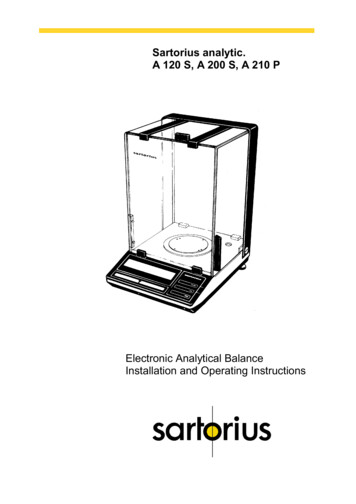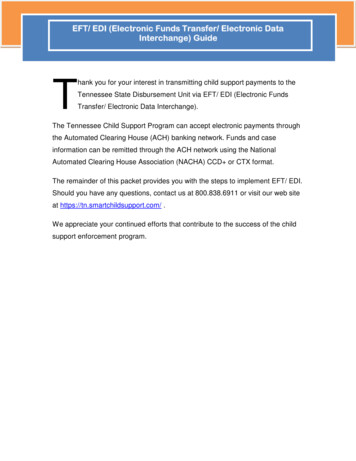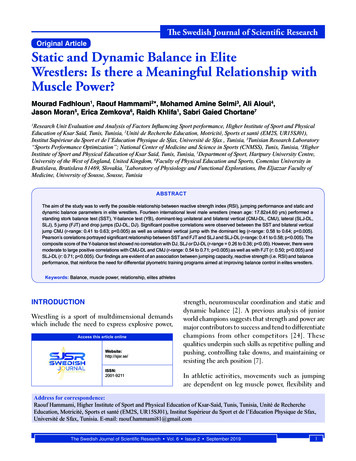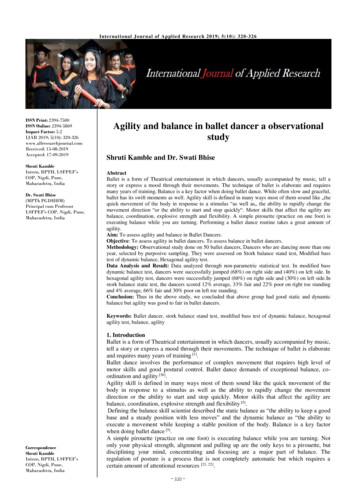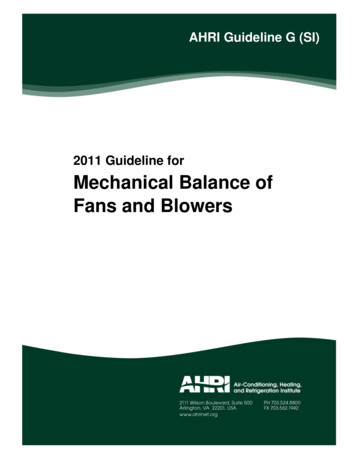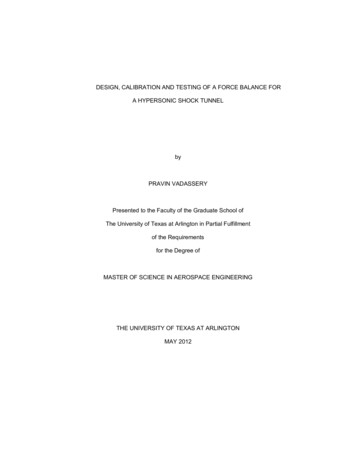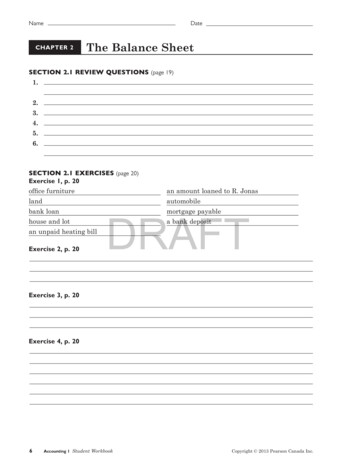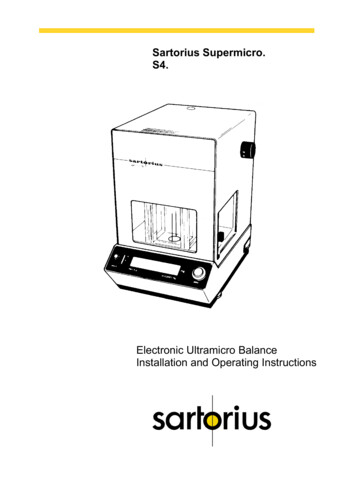
Transcription
Sartorius Supermicro.S4.Electronic Ultramicro BalanceInstallation and Operating Instructions
135791113151719212Pan stirrupZERO buttonArrestment knobInterfaceMOTOR switchSocket (6-terminal)Manufacturer s labelArrestment knobLeveling footFront sliding doorWeight application selector1000-mg tare weights)246810121416182022PanStability indicatorPower receptacle, fuse, voltage selectorManual switch unitPower switchCAL buttonSliding door - sideRange indicatorBRAKE buttonWeight application selector (1000-mg tare weights)Level indicator
Sartorius Supermicro.S4.With this Sartorius Balance you have acquired a sophisticated,top-of-the-line weighing instrument that will help ease your dallywork load.Before you operate your new balance, please read these Installation and operating instructions carefully.This equipment complies with the requirements in Part 15of FCC Rules for a Class A computing device. Operationof this equipment in a residential area may cause unacceptable interference to radio and TV reception requiringthe operator to take whatever steps are necessary tocorrect the interference.Contents.Equipment4How to Handle Your Ultramicro Balance5Startup7Operation10Calibration11Indicators and Controls13Weighing15Balance Operating Program17Troubleshooting Guide20Accessories22Specifications233
Equipment Supplied.Do not miss out on the benefits of our warranty.Please fill out the warranty card, indicating the date of installation, and return the card to your Sartorius dealer.The equipment supplied comprises the componentsshown on the left.Save the packaging materials and the box for shipping yourbalance to prevent any damage caused during transportation.The accessory kit in a case contains the following:— Weighing pan— Pan stirrup— Screwdriver— Forceps— Cloth4
How to Handle YourUltramicro Balance.General Installation InstructionsUltramicro balances are highly precise and very sensitivemeasuring instruments. Therefore, please choose a suitableplace to set up your balance. lt should not be exposed to the following:— heat radiation— components in the atmosphere that have a corrosive or aggressive effect— vibrations— drafts.Set up your balance on a suitable balance fable or use a wallconsole (see "Accessories").Your Sartorius Balance will provide accurate readouts evenwhen it is exposed to unfavorable ambient conditions. You canadapt it to your requirements simply by changing the menucode settings in the balance operating program. For this purpose, please refer to pages 17 to 19.5
Maintenance and CareTo ensure proper care of your electronic S 4 ultramicro balance,all you need to do is regularly calibrate it and clean the weighingpan.Maintenance of your balance should be done at least once ayear by a Sartorius service technician. lf you happen to haveany trouble with your balance, please contact your nearest Sartorius service center.Directions for Working with UltramicrosBefore you Start weighing, please observe the following:After plugging your balance into a wall outlet, make sure to allow between 24 to 48 hours warmup (conditioning time).Working with an ultramicro balance requires a steady hand anda smooth, uninterrupted technique.Use forceps or other suitable Utensils to load your sample onthe pan.Do a few trial weighing procedures before you begin with actualweighing of your sample.The sliding door on the right side (14) may remain open if theweighing chamber is conditioned, dust-free and not exposed todrafts or turbulence. If the weighing chamber has not beenopened for a relatively long period, it may have a temperaturewhich is different from that of the balance's surrounding environment. Therefore, as soon as you open the weighing chamber, a change in temperature will inevitably occur and mayshow up as a change in the weight readout. In this case, werecommend that before you begin with an actual repetitiveweighing procedure you open and dose the weighing chamberat the same rate as you will be doing during such a procedure.Carefully place your sample on the pan and, if necessary, remove it along with the pan.The accuracy of the resulting weight readouts will increase asthe degree of consistency is increased for successive weighingprocedures.Important NoteUnplug your balance before you connect or disconnect peripherals.6
Startup.Insert the plug of the manual switch unit (8) in the socket (11)located on the rear panel of the balance. Secure the connectionby tightening the knurled collar.The balance has been set to 220 volts.How to change the voltage setting:Adjust the voltage selector (6) to your local line voltage. Thesetting on top must match your local line voltage rating. Writethe new setting on the manufacturer's label (13).At the point of use, plug the line cord (power lead) of the balance into a properly installed electrical or wall outlet.lf you use a wall outlet that does not have a protective grounding conductor, make sure to ground your balance.7
At the point of use, level the balance using the leveling feet (17)such that the air bubble is centered within the circle of the levelindicator (22).How to Hook the Weighing PanPress the MOTOR switch (9) to have the pan extractor armautomatically moved outside.Position the weighing pan (2) in the pan stirrup (1), and hookthe pan stirrup on the pan extractor arm.Press the MOTOR switch to retract the pan.8
Releasing the Transport ArrestmentTurn both weight application selectors (20 and 21)to the setting "0000."Pull out arrestment knob (15) toward the right and push it in atsetting "A." You should hear an audible dick.lf you wish to start weighing, turn the arrestment knob to thesetting marked "W."Briefly leave the arrestment knob in setting "B" to prevent theweighing pan from rocking back and forth.9
Operation.Please leave the balance connected to line power for your convenience.Use the power switch (10) to turn your balance on or off.After the balance has been plugged into an electrical outlet, theweight display will go out. All other electronic circuits of the balance will remain energized (standby state). This means the balance is immediately ready to operate without requiring warmupthe next time you switch it on.After the power is turned on, a test of all essential electronic circuits is automatically run.The self-test ends with the readout 0.0000 mg.Now place your sample on the pan (2) to determine its weight(extract and retract the pan to do so). Read off the weight in thedisplay (5) as soon as the stability indicator (4) lights up.lf the weight display does not indicate 0.0000 mg before youbegin to weigh, press the ZERO button (3) to zero it.10
Calibration.Unload the weighing pan, and dose the doors of the weighingchamber. Check the level indicator and relevel the balance, ifnecessary.Adjust the arrestment knob (15) to the setting marked "W" andzero the display.As soon as you obtain a zero readout and the stability indicator(4) lights up, use the screw drive supplied along with the balance to press the CAL button (12). "C" will now appear in theweight display.If "CE" is displayed, tare the balance (zero the display) andpress the CAL button again.Internal CalibrationThe internal calibration weight (100 mg) has anaccuracy “ 1 µg”.Turn the weight application selector (20) to the setting marked"C" and, if necessary, press the pan BRAKE button (18) untilthe weighing pan stops rocking back and forth.After approx. 20 seconds, "C" will flash and then the calibrationweight will be displayed.An acoustic Signal indicates the end of the calibration procedure.Turn the weight application selector (20) back to setting "0.".11
External Calibration- only possible with an accurate calibration weight (100 mg)External calibration is recommended when you are using several balances that have to be calibrated with the same weightfor test series.The calibration weight should be deposited in the chamber between the front and side doors to ensure that it adapts to thetemperature inside.Call the calibration mode readout "C" (see previous page forinstructions). Press the MOTOR switch (9) and then center thecalibration weight on the weighing pan.Press the MOTOR switch again (to automatically retract theweighing pan). lf the weighing pan still rocks, push the BRAKEbutton - pan brake (18).After approx. 20 seconds, "C" will flash and then the calibrationweight readout will appear in the display. An acoustic Signal indicates the end of the calibration procedure.Press the MOTOR switch again (to automatically extract theweighing pan) and remove the calibration weight from theweighing pan.12
Indicators and Controls1. Range IndicatorThe range indicator (16) shows how much of the electric weighing range is used (120 mg), lt operates independently of theweight display.The range indicator must light up at "0 %" when the weight application selectors are set to zero, the arrestment knob is in setting "W," the weighing chamber is closed, and the weighing panis empty.2. BRAKE ButtonPress the BRAKE button (18) to stop the weighing pan fromrocking. Whenever you press the MOTOR switch to retract theweighing pan, the pan brake is automatically activated.3. Arrestment Knob»TA« Transport ArrestmentAdjust the arrestment knob (15) to “TA“ only if youwish to transport the balance.»A« Arrestment— For leveling the balance using the level indicator as aguide— For loading a tare container with an unknown weight»B« Brake Pan Brake- Prevents the weighing pan from rocking»W« Weighing13
4. Weight Application SelectorsYour balance has built-in weights (tare weights) which can beused to mechanically apply a load u p to 3,900 mg.The left weight application selector (20) applies the 1,000-mgweights and the right weight application selector (21) the 100mg weights.Important NoteTurn the weight application selectors to„“TA“ only if the balance to be transported.14
Weighing.1. Absolute WeighingThe arrestment knob (15) is adjusted to "W."Weight application selectors (20 and 21) are set to zero. Tarethe balance, if necessary. Press the MOTOR switch (9) to extract the weighing pan. Now you can place your sample on thepan. Close the side door (14).Press the MOTOR switch to retract the weighing pan. Read offthe weight shown in the weight display as soon as the stabilityindicator (4) lightsup.2. Weighing 120 mgIf the weight display (5) indicates an "H" the electric weighingrange of 120 mg has been exceeded. Turn the 1,000-mg weightapplication selector (20) until the range indicator (16) goes out,and then turn the selector back one setting. Turn the 100-mgweight application selector (21) until the range indicator goesout, and then turn the selector back one setting. Press theBRAKE button (18) until the weighing pan stops rocking. Assoon as the stability indicator lights up, read off the weight displayed.Add the weight displayed to the weights applied.Important Note:The tare weights have an accuracy of:Weight application levels mg 1000Standard set of weightsSet of weights (option)and S 4-**VJAµg 60µg 20100µg 60µg 1015
3. Weighing with a Tare Container (4 g ust arrestment knob to "W."Set weight application selectors to zero.Press the ZERO button.The weight display shows "0.0000" and the stability indicator lights up.Press the MOTOR switch to extract the weighing pan.Place tare container on the weighing pan.Press the MOTOR switch and dose the side door (14)of the weighing chamber."H" lights up in the weight display when ever the weightof the tare Container exceeds the weighing range (120mg).Turn the 1,000-mg weight application selector (20) untilthe range indicator goes out, and then turn the selectorback one setting.Turn the 100-mg weight application selector (21) untilthe range indicator goes out, and then turn the selectorback one setting.Press the BRAKE button until the weighing pan stopsrocking.As soon as the stability indicator lights up, press theZERO button;The weight display now shows 0.0000 mg.Weighing in (see "1. Absolute Weighing")Important Notelf you wish to weigh several components one after theother in the same tare Container, you can zero the display(tare) after weighing in each component to always weighstarting from zero.4. Back WeighingBack weighing, also called reweighing, is done when the weightof a sample has to be determined before and after a fest or experiment.To determine the difference in weight, you must backweigh onthe same weighing pan and with the same tare Container andthe same balance you used for initial weighing.16
Balance OperatingProgram.The balance operating program lets you adapt your balance tovarious ambient conditions and weighing applications.At the factory, we have set the codes for a Standard program,which is protected by a locking function to prevent accidentalchanges.The "code" contains the information of the operating program.II consists of three digits, one each for the page, the line andthe word.How to access the menu of the balance operating program:Turn off the balance. Hold down the ZERO button (3) and simultaneously press the power switch (10). Upon completion of theautomatic self-test, release the ZERO button as soon as "CH5"is displayed. The Status of the balance operating program willbe indicated in the weight display: the letter "L" Stands for thelist mode. In this mode you can check the code setting, but youcannot change it.lf you wish to change a program code, you must first unlock theprogram access function.To do so, switch off the balance (use power switch). Plug themenu access connector (order no. 6738-58) into the femaleconnector (7) of the interface. Hold down the ZERO button (3)again and simultaneously press the power switch (10). Uponcompletion of the automatic self-test, release the ZERO buttonas soon as "CH5" is displayed. The display will now show "C,"representing the change mode, which means you can nowchange the setting.17
After the balance operating program has be
Your Sartorius Balance will provide accurate readouts even when it is exposed to unfavorable ambient conditions. You can adapt it to your requirements simply by changing the menu code settings in the balance operating program. For this pur-pose, please refer to pages 17 to 19. 6 Maintenance and Care To ensure proper care of your electronic S 4 ultramicro balance, all you need to do is .
